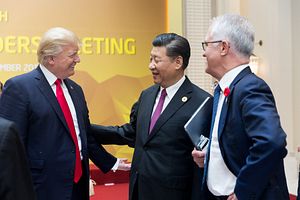The Trump administration has decided to apply aggressive tariffs on China, in large part in response to concerns about Chinese intellectual property theft. The tariffs have both an economic and a national security purpose. On the former, Trump hopes that protectionist measures will help close the large trade gap between the United States and China. The tariff also has a coercive purpose; it demonstrates to China, and to the rest of the world, that Trump is willing to throw around American economic power for the purposes of trade statecraft.
On the national security side, the express purpose of the tariff involves retaliation for Chinese intellectual property practices. These practices include espionage directed at U.S. (and European) IP, lax enforcement of IP standards domestically, and also forced technology transfer from U.S. firms operating in China. These concerns involve both economic statecraft (preventing China from obtaining on unfair advantage in particular strategic industries) and defense statecraft (punishing China for the illicit acquisition of U.S. defense technologies).
Apart from direct concerns over the possibility of a trade war, the tariffs have created some concerns domestically and internationally. With respect to the latter, the tariffs have proven controversial with domestic business interests, especially those dependent upon trade with China. The double-edged sword is evident; on the one hand, many U.S. producers are happy to see pressure put on China to better protect IP, but on the other, many U.S. firms were willing to transfer technology in return for access to China’s labor and consumer markets. That access may now be in peril.
The United States and China have also clashed in the multilateral fora tasked with managing international IP disputes. The U.S. actions evoked some controversy at the WTO, as some members have questioned the decision to punish China. U.S. claims seem to go beyond what the WTO generally considers to be violations of its rules, and in any case the Trump administration has displayed considerable skepticism about the WTO as a mechanism for resolving trade disputes.
While coercive action offers a degree of satisfaction to the United States (and presumably to Trump’s base), it’s not obviously the best way to earn Chinese compliance. U.S. actions can have lethal effects on foreign companies, and damaging effects on American firms. James Andrew Lewis estimates U.S. losses to cyberespionage alone at $20-30 billion annually, but there is no question that China has responded to internal and external incentives to update and strengthen its IP regime. The Obama-Xi agreement didn’t stop Chinese espionage, but by almost every account it significantly curtailed such activity. And of course, the United States demonstrated a lax approach to IP protection in the 19th century, but then again the technological context is much different in the digital era.
In any case, Trump has taken a much harder line on Chinese IP violations that his predecessors, despite the evident progress that the previous approaches saw. It remains to be seen how effectively China will respond.

































